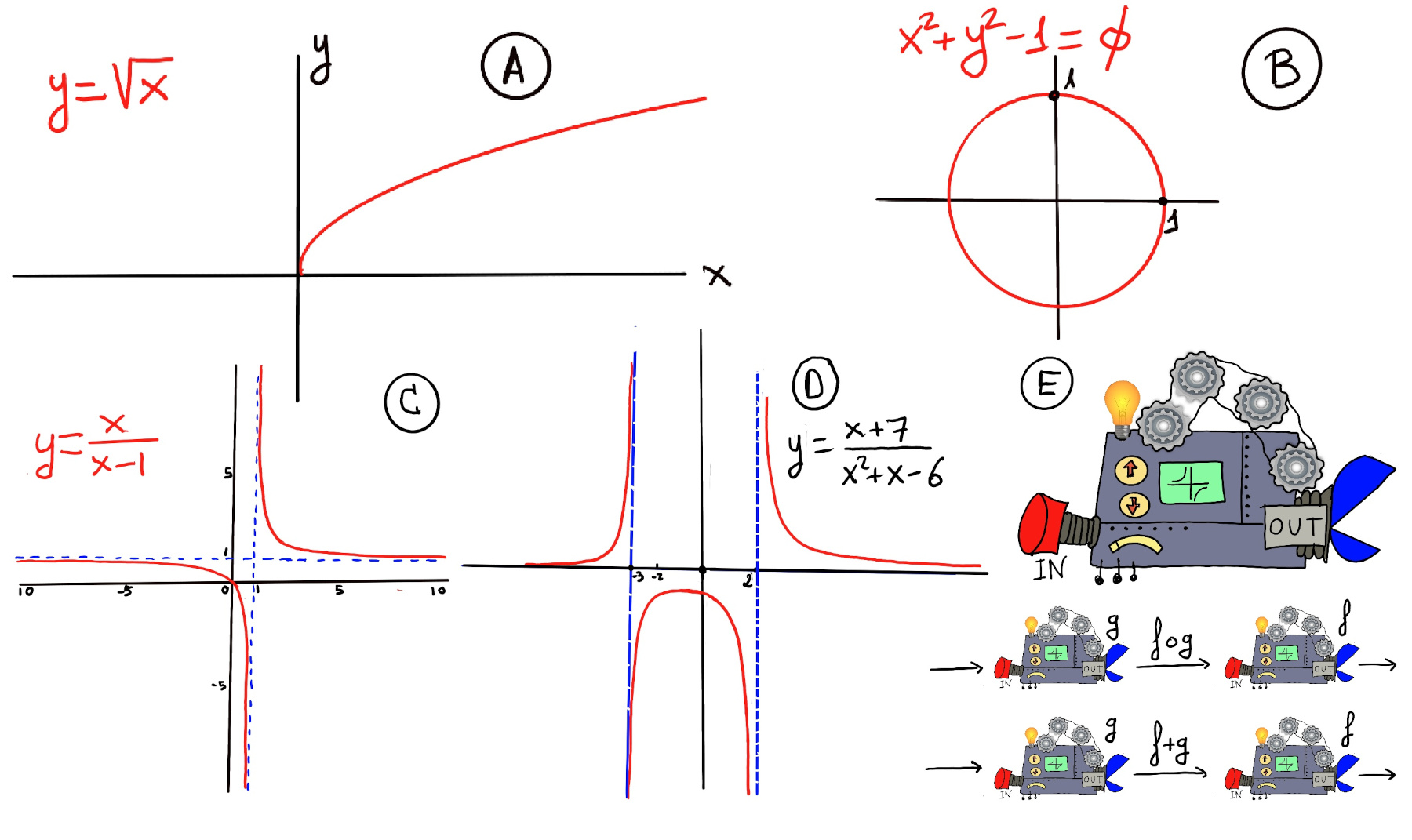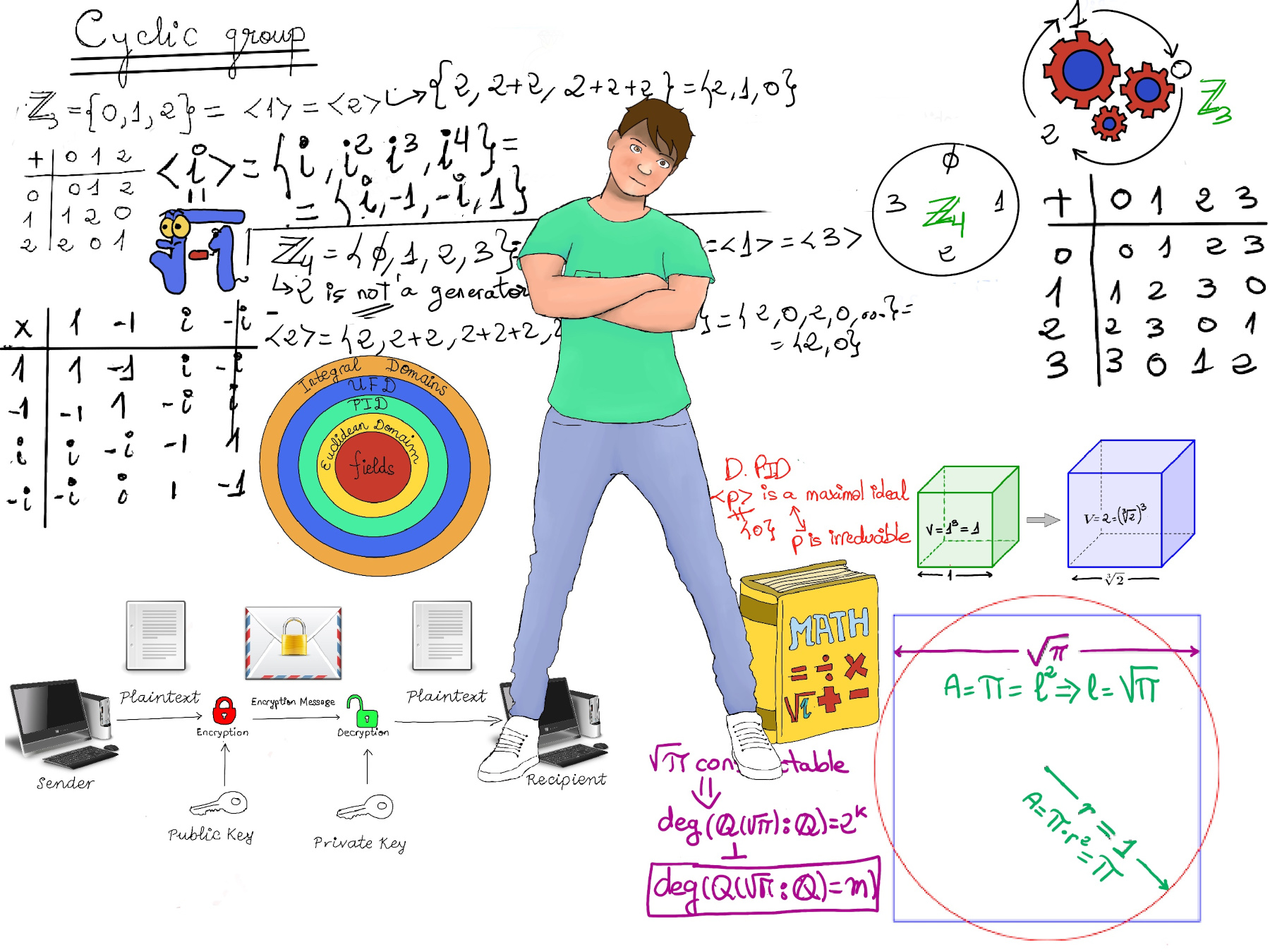
|
 |
 |

|
 |
 |
Older people shouldn’t eat health food, they need all the preservatives they can get, Robert Orben.
Definition. A function f is a rule, relationship, or correspondence that assigns to each element of one set (x ∈ D), called the domain, exactly one element of a second set, called the range (y ∈ E).
The pair (x, y) is denoted as y = f(x). Typically, the sets D and E will be both the set of real numbers, ℝ. A mathematical function is like a black box that takes certain input values and generates corresponding output values (Figure E).

Graphing functions involves the visual representation of a curve that reflects the behavior of a mathematical function on a coordinate plane, also known as the Cartesian plane. It is a two-dimensional space defined by two axes, namely the x-axis (horizontal) and the y-axis (vertical).
A systematic approach to graphing a function begins by constructing a table containing selected input values and their corresponding output values. By extending this table, we can plot the points on the coordinate plane and observe the pattern they form. Connecting these points reveals the shape of the curve, allowing us to gain insights into the behavior of the function across its domain. This process provides a visual means of understanding the relationships between different variables and aids in interpreting the overall characteristics of the function.

Algebra of functions involves operations and manipulations applied to functions. Consider the scenario where we aim to sum the individual annual incomes of both a husband and a wife to obtain their total household income for each year. If w(x) signifies the wife’s income and h(x) denotes the husband’s income, and we wish to express the total income as T, we can define a new function, t(x) = h(x) + w(x).
We can combine existing functions. One way is to use function composition where we evaluate or apply one function to another, that is, where we take the output of one function and feed it into another, (e.g., sin(x2), log(1⁄x), $\sqrt{1-x^2}$). Another way is to carry out the basic four arithmetic operations on functions. For any arithmetic operation of two functions at an input, we just have to apply the same operation with the function outputs (Figure E).

Let f and g be functions:
Example: f(x) = 3x, g(x) = -x3, (f + g)(x) = 3x -x3.
Example: f(x) = x2+2, g(x) = x + 7, (f + g)(x) = x2 + x + 9.
For doing any arithmetic operation of two functions, their domains must be the same (it is typically the set of all real numbers, ℝ) or the domain is the intersection of the domains of both functions, i.e., Domain(f + g) = Domain(f) ∩ Domain(g), Domain(f - g) = Domain(f) ∩ Domain(g), and Domain(fg) = Domain(f) ∩ Domain(g).
Example: f(x) = x2, g(x) = x -1, (f - g)(x) = x2 -x +1.
Example: f(x) = (x+2), g(x) = (x2+3x+7), (f - g)(x) = f(x) - g(x) = (x+2) - (x2+3x+7) = -(x2 + 2x + 5).
Scalar multiplication of a function. (kf)(x) = kf(x), ∀x∈ Domain(f), e.g., f(x) = sin(x), k = 2, 2sin(x) or ex, k = 3, 3ex.
(fg)(x) = f(x)g(x). Domain(f·g) = Domain(f) ∩ Domain(g)
Example: f(x) = x, g(x) = 2, (fg)(x) = 2x.
Example: f(x) = (x+2), g(x) = (x2+3x+7), (fg)(x) = f(x)g(x) = (x+2)*(x2+3x+7) = x3 + 5·x2 + 13x + 14.
Example: f(x) = x, g(x) = x -1, $(\frac{f}{g})(x)=\frac{x}{x-1},$ (Figure C).
f/g is obviously not defined at x = 1. $Domain(\frac{f}{g})= ℝ - {x| g(x) ≠ 0} = ℝ - {1}$
$(\frac{f}{g})’(x)= \frac{1·(x-1)+x·1}{(x-1)^2} = \frac{-1}{(x-1)^2}$ ⇒ $(\frac{f}{g})$ is strictly decreasing.
$\lim_{x \to ∞} \frac{x}{x-1} = 1, \lim_{x \to -∞} \frac{x}{x-1} = 1$. The function has a horizontal asymptote at y = 1, where the function approaches as x goes to infinity or negative infinity.
L’Hôpital’s rule: $\lim_{x \to ∞} \frac{x}{x-1} = \lim_{x \to ∞} \frac{1}{1} = 1$
$\lim_{x \to 1-} \frac{x}{x-1} = -∞, \lim_{x \to 1+} \frac{x}{x-1} = ∞$. The function has a vertical asymptote at x = 1, where the function is undefined. The function has a y-intercept at (0,0) and an x-intercept at (0,0).

Example: f(x) = (x+7), g(x) = (x2+x-6), (f/g)(x) = f(x)/g(x) = $\frac{x+7}{x^2+x-6}$ (Figure D).
f/g is not defined at x = 2 and x = -3. $Domain(\frac{f}{g})= ℝ$ - {x| g(x) ≠ 0} = ℝ - {2, -3}.
$(\frac{f}{g})’(x)= \frac{x^2+x-6-(2x+1)(x+7)}{(x^2+x-6)^2} = \frac{x^2+x-6-2x^2-14x-x-7}{(x^2+x-6)^2} = \frac{-x^2-14x-13}{(x^2+x-6)^2} = -\frac{x^2+14x+13}{(x^2+x-6)^2} = -\frac{(x+13)(x+1)}{(x-2)^2(x+3)^2}$.
f’ > 0 (f increasing) in (-13, -1) and f’ < 0 (f decreasing) in (-∞, -13) -this cannot be appreciate it in the plot- ∪ (-1, ∞). The critical points include 2 and -3, but we can exclude those from our analysis because the denominator is always positive.
We use the test point method to determine the sign of a function in each interval defined by its critical points.
$\lim_{x \to ∞} \frac{x+7}{x^2+x-6} = 0, \lim_{x \to -∞} \frac{x+7}{x^2+x-6} = 0$. The function has a horizontal asymptote at y = 0, where the function approaches as x goes to infinity or negative infinity.
L’Hôpital’s rule: $\lim_{x \to ∞} \frac{x+7}{x^2+x-6} = \lim_{x \to ∞} \frac{1}{2x+1} = 0.$
$\lim_{x \to -3⁻} \frac{x+7}{x^2+x-6} = \lim_{x \to -3⁻} \frac{(x+7)}{(x-2)(x+3)} = ∞, \lim_{x \to -3⁺} \frac{x+7}{x^2+x-6} = \lim_{x \to -3⁺} \frac{(x+7)}{(x-2)(x+3)} = -∞$
$\lim_{x \to 2⁻} \frac{x+7}{x^2+x-6} = \lim_{x \to 2⁻} \frac{(x+7)}{(x-2)(x+3)} = -∞, \lim_{x \to 2⁺} \frac{x+7}{x^2+x-6} = \lim_{x \to 2⁺} \frac{(x+7)}{(x-2)(x+3)} = ∞$. The function has vertical asymptotes at x = -3 and x = 2.

We use the test point method to determine the sign of $\frac{x+3}{x-4}$. The critical points in this case if when x + 3 = 0 or x -4 = 0, that is, -3 and 4 respectively.
Therefore, the domain is (∞, -3) ∪ (4, ∞).